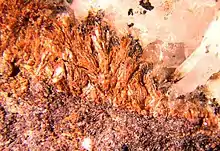| Sursassite | |
|---|---|
 | |
| General | |
| Category | Sorosilicate |
| Formula (repeating unit) | Mn2+2Al3(SiO4)(Si2O7)(OH)3 |
| IMA symbol | Ss[1] |
| Strunz classification | 9.BG.15 |
| Crystal system | Monoclinic |
| Crystal class | Prismatic (2/m) (same H-M symbol) |
| Space group | P21/m |
| Identification | |
| Color | Red-brown to copper-red |
| Crystal habit | Botryoidal |
| Cleavage | [101] Distinct |
| Mohs scale hardness | 3 |
| Luster | Silky, Dull |
| Streak | yellow-brown |
| Diaphaneity | Translucent |
| Density | 3.256 |
| Optical properties | Biaxial |
| Refractive index | 1.73 to 1.76 |
| Birefringence | 0.030 |
| Pleochroism | Strong; X = Z = colorless to pale yellow; Y = deep golden brown. |
| Dispersion | r > v |
| References | [2][3] |
Sursassite is a sorosilicate mineral. It was first discovered in 1926.[4] It was first found in the Sursass (Oberhalbstein), a district of Graubünden, Switzerland. It is generally found in deposits of metamorphosed manganese.[5]
Notes
- ↑ Warr, L.N. (2021). "IMA–CNMNC approved mineral symbols". Mineralogical Magazine. 85 (3): 291–320. Bibcode:2021MinM...85..291W. doi:10.1180/mgm.2021.43. S2CID 235729616.
- ↑ Pierre Perroud. "Sursassite". Athena Mineralogy: Mineral Data.
- ↑ Sursassite details from Handbook of Mineralogy
- ↑ Schweizerische mineralogische und petrographische Mitteilungen (1926), 6, 376-380.
- ↑ Barthelmy, Dave. "Sursassite Mineral Data". WebMineral. Retrieved 2009-03-17.
This article is issued from Wikipedia. The text is licensed under Creative Commons - Attribution - Sharealike. Additional terms may apply for the media files.